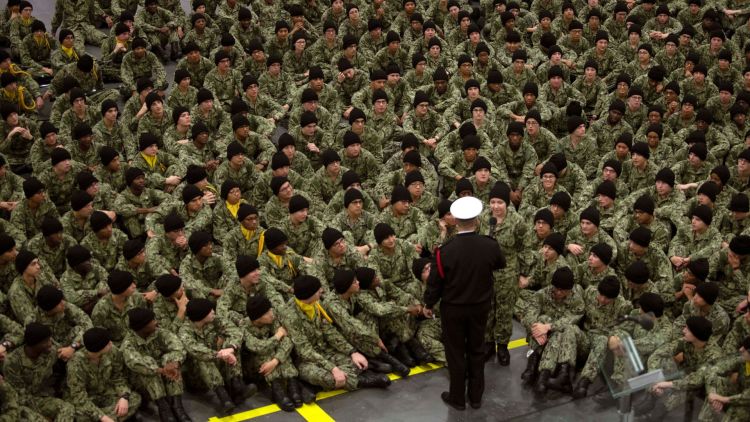For the first time in three years, the US Navy is set to hit its recruitment goals.
Navy recruiting officials announced on Thursday, August 29, that they’re “likely to meet” their recruiting target of 40,600 active-duty sailors for Fiscal Year 2024. This goal is higher than last year’s, even though the Navy didn’t quite hit the mark then.
Rear Adm. Jeffrey Czerewko, commander of Naval Education and Training Command, told reporters during a roundtable before October’s official count that they are “on track to meet the goal,” according to a report from USNI News.
At first glance, that sounds like a win, but if you look closer, some concerns come up.
Is the Navy actually getting the right kind of recruits to keep the force strong and ready, or is it just trying to hit the numbers?
With recent changes in how they’re recruiting and a bigger focus on diversity, equity, and inclusion (DEI), there’s a growing debate: Are these moves really helping the Navy, or could they be doing more harm than good?
Here’s our take on the matter.
Rewriting the Rules: How the Navy’s Recruiting is Changing
To hit its recruitment goals, the Navy has made some big changes.
For the first time in three years, the US Navy is set to hit its recruitment goals.
Navy recruiting officials announced on Thursday, August 29, that they’re “likely to meet” their recruiting target of 40,600 active-duty sailors for Fiscal Year 2024. This goal is higher than last year’s, even though the Navy didn’t quite hit the mark then.
Rear Adm. Jeffrey Czerewko, commander of Naval Education and Training Command, told reporters during a roundtable before October’s official count that they are “on track to meet the goal,” according to a report from USNI News.
At first glance, that sounds like a win, but if you look closer, some concerns come up.
Is the Navy actually getting the right kind of recruits to keep the force strong and ready, or is it just trying to hit the numbers?
With recent changes in how they’re recruiting and a bigger focus on diversity, equity, and inclusion (DEI), there’s a growing debate: Are these moves really helping the Navy, or could they be doing more harm than good?
Here’s our take on the matter.
Rewriting the Rules: How the Navy’s Recruiting is Changing
To hit its recruitment goals, the Navy has made some big changes.
First off, they’ve lowered entry standards, the same as the rest of the service branches, allowing recruits with lower exam scores and raising the maximum enlistment age to 42.
Sure, this lets in a wider range of people, but it also raises the question of whether the Navy is sacrificing quality for quantity.
They’ve also widened the eligibility pool, now accepting some recruits without a high school diploma.
They say this is about giving more opportunities to motivated Americans, but some folks worry it might lower the overall talent level of the fleet.
During a Navy recruiting event at Quincy Market last year on March 18, 2023. (DVIDS)
By loosening these rules, the Navy is definitely making it easier to meet its numbers, but at what cost?
Plus, the Navy has stretched out its recruitment timelines with a delayed entry program, which helps pad their numbers by letting recruits sign up now and ship out to boot camp later.
This might seem like a good way to fill the ranks, but it also raises the question: Is this just a quick fix to make the stats look better, or a solid plan for the future?
How Cultural Shifts Are Shaping the Navy
Beyond just changing up how it recruits, the Navy is going through a bit of a culture shift, too.
There’s a bigger focus now on diversity, equity, and inclusion (DEI), which is shaking things up within the service.
DEI is important for making sure everyone feels welcome, but some folks think this new direction might be pushing away those who are used to a more traditional military culture.
There’s also a growing view that the Navy is becoming too “politically correct” or “woke,” and some think that’s turning off potential recruits who want a different kind of military experience.
Whether that’s true or not, this perception could be making it harder for the Navy to attract and keep the kind of people it needs to stay strong.
Sailors graduating from boot camp march into Midway Ceremonial Drill Hall on July 25, 2024. (DVIDS)
What Do These Changes Mean for the Navy’s Future?
So, what does this mean for the Navy’s future? Or at least what we think the service means.
Lowering recruitment standards and focusing on new cultural priorities might help hit the numbers right now, but there are some real risks involved.
If the Navy focuses more on getting people in the door than on the quality of those recruits, it could struggle to stay effective, especially as global threats keep evolving and getting more complex.
It’s important to strike the right balance between promoting diversity and inclusion and maintaining the Navy’s high standards.
The service branch needs to make sure it’s bringing in people who are ready to serve while still being an inclusive and welcoming environment.
Given the recruitment challenges in recent years, it’s clear that finding this balance isn’t easy, but it’s crucial for keeping the Navy strong and capable in the long run.
Where Does This Leave Us?
The Navy’s latest recruitment tactics and cultural shifts are sparking some big questions about its future.
Sure, hitting recruitment targets is a good thing, but it’s just as important to make sure these new recruits are up to the Navy’s high standards and ready for the challenges ahead.
The service needs to take a good, hard look at its approach to bringing in new people and shaping its culture—not just to meet short-term goals but to make sure it’s ready for whatever comes next.
The decisions made now will have a lasting impact on the Navy’s strength and readiness down the road.
—
Disclaimer: SOFREP utilizes AI for image generation and article research. Occasionally, it’s like handing a chimpanzee the keys to your liquor cabinet. It’s not always perfect and if a mistake is made, we own up to it full stop. In a world where information comes at us in tidal waves, it is an important tool that helps us sift through the brass for live rounds.



